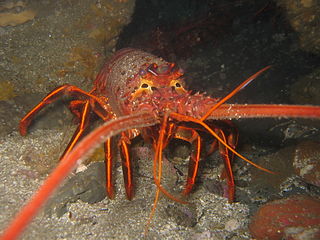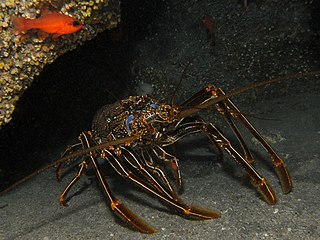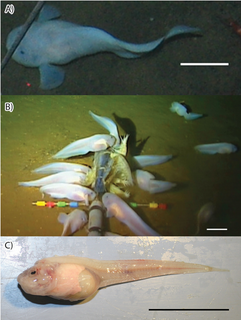
The Mariana Trench or Marianas Trench is located in the western Pacific Ocean about 200 kilometres (124 mi) east of the Mariana Islands; it is the deepest oceanic trench on Earth. It is crescent-shaped and measures about 2,550 km (1,580 mi) in length and 69 km (43 mi) in width. The maximum known depth is 10,984 metres (36,037 ft) at the southern end of a small slot-shaped valley in its floor known as the Challenger Deep. However, some unrepeated measurements place the deepest portion at 11,034 metres (36,201 ft). By comparison: if Mount Everest were placed into the trench at this point, its peak would still be over two kilometres (1.2 mi) under water.

The Liparidae, commonly known as snailfish or sea snails, are a family of scorpaeniform marine fishes.

The Atlantic mackerel, also known as Boston mackerel, Norwegian mackerel, Scottish mackerel or just mackerel, is a species of mackerel found in the temperate waters of the Mediterranean Sea, the Black Sea, and the northern Atlantic Ocean, where it is extremely common and occurs in huge shoals in the pelagic zone down to about 200 m (660 ft). It spends the warmer months close to shore and near the ocean surface, appearing along the coast in spring and departing with the arrival of colder weather in the fall and winter months. During the fall and winter, it migrates out into deeper and more southern water, seeking warmer temperatures.

The California spiny lobster is a species of spiny lobster found in the eastern Pacific Ocean from Monterey Bay, California to the Gulf of Tehuantepec, Mexico. It typically grows to a length of 30 cm (12 in) and is a reddish-brown color with stripes along the legs, and has a pair of enlarged antennae but no claws. The interrupted grooves across the tail are characteristic for the species.

The swell shark is a catshark in the family Scyliorhinidae. It is found in the subtropical eastern Pacific Ocean between central California and to southern Mexico, with an additional population off the coast of Chile. As a defense, the swell shark is able to expand to approximately double its regular size by swallowing water.

Palinurus elephas is a commonly caught species of spiny lobster from the East Atlantic Ocean and the Mediterranean Sea. Its common names include European spiny lobster, crayfish or cray, common spiny lobster, Mediterranean lobster and red lobster.

The shagreen ray, also known as shagreen skate or fuller's ray, is a species of skate in the family Rajidae. This ray is found in the eastern Atlantic Ocean, from Murmansk, Russia through Norway, southern Iceland, the Faroe Islands, the Celtic Sea, the northern North Sea and Skagerrak, to northern Morocco, including (infrequently) the western Mediterranean Sea and the Madeira Islands. It is absent from the shallow waters off England and Wales.

The spiny butterfly ray or giant butterfly ray is a species of butterfly ray, family Gymnuridae, native to the shallow coastal waters of the Atlantic Ocean. A large ray that can measure over 2 m across, it may be distinguished from the sympatric smooth butterfly ray by the spine at the base of its tail and by a small tentacular structure on the margin of each spiracle. Slow-reproducing and valued for its meat, in recent decades its population has experienced a decline of over 30%, and it has become Critically Endangered in certain parts of its range.

The quillback rockfish is one of 130 species of rockfish and primarily dwells in salt water reefs. The average adult weighs 2-7 pounds and may reach 1 m in length. Quillback rockfish are named for the sharp, venomous quills or spines on the dorsal fin. Their mottled orange-brown coloring allows them to blend in with rocky bottom reefs. The quillback rockfish eats mainly crustaceans, but will also eat herring. They are solitary and minimally migratory, but not territorial, and give birth to live young (viviparous). They are a popular sport fish, generally caught in cold water 41–60 m deep, but also to subtidal depths of 275 m.

Careproctus is a genus of snailfishes found in benthic and benthopelagic habitats in the Atlantic, Pacific, Arctic and Southern Oceans. Whether they truly are absent from the Indian Ocean, except for a couple of species in Subantarctic waters, is unknown and might be an artifact of limited sampling. They range from shallow coastal seas in the far north of their range to the abyssal zone, at depths of 6 to 5,459 m (20–17,910 ft). In the Northern Hemisphere they mostly live shallower than Paraliparis, but this pattern is reversed in the Southern Hemisphere. Although almost entirely restricted to very cold waters, a single species, C. hyaleius, lives at hydrothermal vents.

Liparis fabricii, commonly known as the gelatinous seasnail or gelatinous snailfish, is a benthopelagic species of snailfish from the Arctic Ocean. It has a tadpole-like body with a maximum length of about 20 cm (7.9 in). It is brown to black in coloration with a distinctive dark peritoneum. It preys on small crustaceans and marine worms. It is not commercially important, though it is a valuable food source for predatory fish and seabirds in the Arctic region.
Acantholiparis is a genus of snailfishes native to the northern Pacific Ocean.

Liparis agassizii, in one instance called "agassiz's snailfish", is a fish from the genus Liparis. It lives in the North Pacific Ocean at a depth range between zero and one hundred meters. The fish may especially be found from the Iwate Prefecture to Hokkaido, off the coast of Primorskiy, off the western and southeastern coast of Sakhalin, and in the southern Kuril Islands.
Liparis tunicatus, or the kelp snailfish, is a species of snailfish from the genus Liparis. It can be found in marine, demersal waters at a depth range from 0 to 620 m (0–2,034 ft). The kelp snailfish lives in the Arctic and Northwest Atlantic Ocean among kelp. The species is common, at least around Greenland and Franz Josef Land. A bottom feeder, it eats small crustaceans. At Franz Josef Land, it spawns in March at a depth of 6–25 m (20–82 ft), with the egg clusters attached to kelp.

Panulirus echinatus, the brown spiny lobster, is a species of spiny lobster that lives on rocky reefs in the tropical western Atlantic Ocean and central Atlantic Islands.
Acantholiparis opercularis, or the spiny snailfish, is one of two species within the snailfish genus Acantholiparis. The generic name comes from the Greek akantha meaning "thorn" and liparis meaning "fat". The specific name comes from the Latin opercularis, meaning covered.

Sebastes reedi is a species of fish in the rockfish family found in the Eastern Pacific.

The Pacific spiny dogfish is a common species of the Squalidae (dogfish) family of sharks and are among the most abundant species of sharks in the world. This species is closely related to Squalus acanthias and for many years they were treated as a single species. Recent research, using meristic, morphological and molecular data led to the resurrection of Pacific Spiny Dogfish as a separate species. The American Fisheries Society recommends the common name "Pacific Spiny Dogfish" for Squalus suckleyi over alternatives such as "Spotted Spiny Dogfish" and "North Pacific Spiny Dogfish" and "Spiny Dogfish" for Squalus acanthias.

Pseudoliparis swirei, the Mariana snailfish or Mariana hadal snailfish, is a species of snailfish found at hadal depths in the Mariana Trench in the western Pacific Ocean. It is known from a depth range of 6,198–8,076 m (20,335–26,496 ft), including a capture at 7,966 m (26,135 ft), which possibly is the record for a fish caught on the seafloor. Various anatomical, physiological, molecular and genetic adaptions help this species survive in such depths.
Halocynthia igaboja, commonly known as the sea hedgehog, the bristly tunicate or spiny sea squirt, is a species of tunicate in the family Pyuridae. It is native to the northeastern Pacific Ocean. This species was first described in 1906 by the Japanese marine biologist Asajiro Oka, who gave it the name Cynthia ritteri. It was later transferred to the genus Halocynthia.















